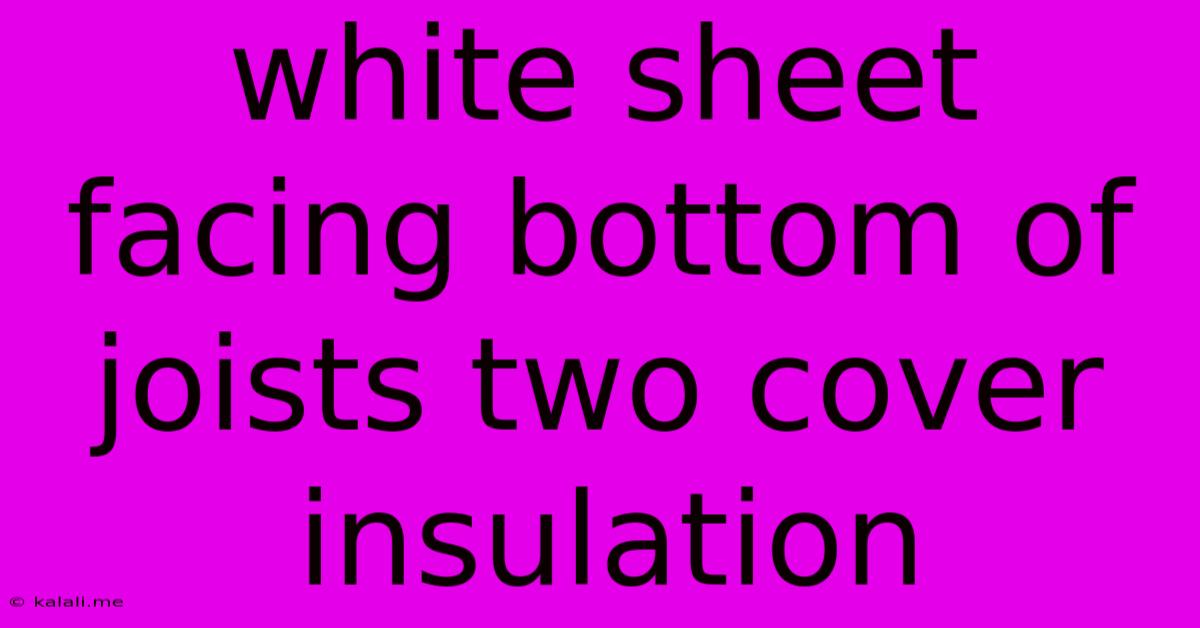White Sheet Facing Bottom Of Joists Two Cover Insulation
Kalali
Jun 10, 2025 · 3 min read

Table of Contents
White Sheet Facing Bottom of Joists: Understanding Its Role in Insulation
This article explores the purpose and function of the white sheet often found facing the bottom of joists, specifically in relation to insulation. We'll delve into its material, its role in vapor barriers, and how it contributes to a more energy-efficient home. Understanding this seemingly simple element is crucial for maximizing your home's insulation performance.
What is that White Sheet?
That white sheet you see attached to the bottom of your joists is likely a polypropylene vapor barrier. While sometimes appearing as a plastic sheet, it's usually made from a breathable material designed to control moisture movement within your home's structure. It's a crucial component in preventing moisture from accumulating within your insulation, leading to mold growth, structural damage, and reduced insulation efficiency. Think of it as a sophisticated protective layer for your home's insulation system. Other materials might be used, but polypropylene is a common and effective choice.
Why is it Important?
The primary function of this white sheet is to act as a vapor retarder. This means it slows down the passage of water vapor. In colder climates, warm, moist air from inside your home can migrate into the colder attic space. If this moisture comes into contact with the insulation, it can condense, leading to damp insulation which loses its effectiveness. The vapor barrier minimizes this risk. Therefore, this layer is essential in maintaining the integrity and performance of your insulation. It's a crucial part of your home's thermal envelope.
Insulation and the Vapor Barrier: A Powerful Duo
The combination of insulation and a vapor barrier works synergistically to create a more energy-efficient and healthy living space. The insulation itself prevents heat loss in the winter and heat gain in the summer, while the vapor barrier protects the insulation from moisture damage. This ensures your insulation performs optimally, saving you money on your energy bills and contributing to a comfortable and dry home environment. The proper installation of this barrier is critical; gaps or tears can compromise its functionality.
Choosing the Right Material and Installation
While polypropylene is common, it's important to select a vapor barrier appropriate for your climate and insulation type. Consult building codes and professional advice to ensure you use the correct material. Proper installation is just as crucial as material selection. The sheet should be sealed tightly at seams and edges to avoid any gaps that could allow moisture to penetrate. This is where attention to detail during construction or renovation pays off significantly. Overlapping the sheets and using appropriate sealant tape is key to ensuring an effective vapor barrier.
Potential Issues and Troubleshooting
If you notice signs of moisture or mold in your attic, it could indicate a problem with your vapor barrier. This could stem from improper installation, damaged material, or other factors influencing moisture levels within your attic space. Addressing such issues promptly is vital to prevent further damage and maintain the efficiency of your home's insulation. Proper ventilation is also key.
In conclusion, the seemingly insignificant white sheet beneath your joists plays a vital role in ensuring the longevity and efficiency of your home's insulation. Understanding its function, proper installation, and potential issues can contribute significantly to a warmer, drier, and more energy-efficient home. Don't underestimate the impact of this often-overlooked component.
Latest Posts
Latest Posts
-
Adjective That Starts With A To Describe A Mom
Jun 12, 2025
-
How To Convert Base 8 To Hexadecimal
Jun 12, 2025
-
Which One Of The Following Is A Chemical Change
Jun 12, 2025
-
977 Is Code Of Which Country
Jun 12, 2025
-
Which Of The Following Statements Is A Positive Economic Statement
Jun 12, 2025
Related Post
Thank you for visiting our website which covers about White Sheet Facing Bottom Of Joists Two Cover Insulation . We hope the information provided has been useful to you. Feel free to contact us if you have any questions or need further assistance. See you next time and don't miss to bookmark.